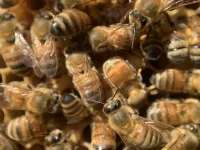(Press-News.org) Honeybees play a scent-driven game of telephone to guide members of a colony back to their queen, according to a new study led by University of Colorado Boulder. The research, published today in the Proceedings of the National Academy of Sciences, highlights how insects with limited cognitive abilities can achieve complex feats when they work together--even creating what looks like a miniature and buzzing version of a telecommunications network.
The findings also serve as a testament to a honeybee's love for its queen. These matriarchs are the most important members of any hive: They're the only females able to reproduce. Queens, like other members of a colony, can also communicate using pheromones, or small and odorous molecules that bees produce through special glands.
"It's very important for the bees to know where the queen is and to stay close to her," said study author Orit Peleg, an assistant professor in the BioFrontiers Institute and Department of Computer Science at CU Boulder.
Pheromones, which are too small for scientists to observe directly, can only travel so far before they dissipate into the air.
So bees get creative to pass the messages along. Drawing on experiments with live bees and computer simulations, or models, Peleg and her colleagues discovered that when a queen starts sending out pheromones, nearby insects take note. They stop what they're doing, start making their own pheromones, then transmit those scents to friendly bees that are farther away.
Peleg added that the results could one day help engineers to design more efficient telecommunications networks--for humans.
"There are many examples of animals, like ants, who lay pheromones in their environments," Peleg said. "But those pheromones just disperse passively by the laws of physics. Here, the bees are actively directing that signal."
Shake it
That conclusion, she added, came about from a chance observation. During a previous study, Peleg and her colleagues were tracking how honeybees form giant swarms--or undulating blobs made up of thousands to as many as 100,000 bees.
In the process, the researchers spotted something strange. As the honeybees in their experiments gathered around a queen to build a swarm, large numbers of them began to engage in what scientists call the "scenting" behavior. They stuck their hind ends into the air and beat their wings furiously.
"When they fan their wings, they're drawing air over their pheromone glands, blowing those molecules away," Peleg said.
She and her team wanted to know what was behind this insect version of twerking.
To do that, the group set up a video camera in an arena and recorded bees in the process of forming a swarm. The researchers then analyzed that footage using machine learning tools that automatically tracked the locations and orientations of the bees in a colony.
The team discovered the bees didn't seem to spread their scent randomly.
"The signal is broadcasted in a particular direction, and that direction tends to be away from the queen," Peleg said.
Phoning home
Picture an insect phone tree: The bees closest to the queen catch whiff of her smell molecules, then blow their own pheromones to the bees behind them. That next layer of bees passes the message on in turn, and the chain continues until every bee in the colony is in on the secret.
"It almost resembles a telecommunications network where you have antennas that are talking to each other and amplifying the signal so that it can reach farther away," Peleg said.
Dieu My Nguyen, lead author of the study, noted that at the height of this communication frenzy, a hive's messenger bees mostly spaced themselves evenly across an arena.
"The distances between the scenting bees were very uniform," said Nguyen, a graduate student in computer science at CU Boulder. "That suggests that there is some sort of concentration threshold over which pheromones are detectable, and that the bees were responding to that."
Peleg, Nguyen, and their colleagues say that there is still a lot that they don't know about how these communications networks work. Do only some bees, for example, transmit messages for the queen, or can all members of a hive sniff and fan when it suits them? For now, the team is happy to get a new whiff of the social lives of these curious insects.
"We got a few bee stings," Nguyen said. "But it was worth it for those nice movies."
INFORMATION:
Other coauthors on the new study include CU Boulder graduate student Michael Iuzzolino and undergraduate student Aaron Mankel. Katarzyna Bozek of the Cologne University Hospital and Greg Stephens of the Okinawa Institute of Technology and Vrije Universiteit Amsterdam also contributed to this research.
Given the finite nature of fossil fuel reserves and the devastating environmental impacts of relying on fossil fuels, the development of clean energy sources is among the most pressing challenges facing modern industrial civilization. Solar energy is an attractive clean energy option, but the widescale implementation of solar energy technologies will depend on the development of efficient ways of converting light energy into chemical energy.
Like many other research groups, the members of Professor Takehisa Dewa's research team at Nagoya Institute of Technology in Japan have turned to biological photosynthetic apparatuses, which ...
[Background]
Decreasing the emission and efficient utilization (fixation) of carbon dioxide (CO2) are worldwide issues to prevent global warming. Promotion of the use of renewable energy is effective in reducing CO2 emissions. However, since there are large time-dependent fluctuations and large regional differences in renewable energy production, it is necessary to establish a fixation technology to allow efficient energy transportation and storage. Thus, there is increasing interest in technologies for synthesizing useful chemicals from CO2 using electricity derived from renewable energy. ...
A new study suggests that Sargramostim, a medication often used to boost white blood cells after cancer treatments, is also effective in treating and improving memory in people with mild-to-moderate Alzheimer's disease. This medication comprises of a natural human protein produced by recombinant DNA technology (yeast-derived rhu GM-CSF/Leukine®).
The study, from the University of Colorado Alzheimer's and Cognition Center at the University of Colorado Anschutz Medical Campus (CU Anschutz), presents evidence from their clinical trial that shows that Sargramostim may ...
(Boston)--Being persistently lonely during midlife (ages 45-64) appears to make people more likely to develop dementia and Alzheimer's Disease (AD) later in life. However, people who recover from loneliness, appear to be less likely to suffer from dementia, compared to people who have never felt lonely.
Loneliness is a subjective feeling resulting from a perceived discrepancy between desired and actual social relationships. Although loneliness does not itself have the status of a clinical disease, it is associated with a range of negative health outcomes, including sleep disturbances, depressive symptoms, cognitive impairment, and stroke. Still, feeling lonely may happen to anyone at some point in life, ...
A new study shows that if the population were fixed at current levels, the risk of population displacement due to river floods would rise by ~50% for each degree of global warming. However, if population increases are taken into account, the relative global flood displacement risk is significantly higher.
The research, by an international team from Switzerland, Germany, and the Netherlands, used a global climate-, hydrology- and inundation-modelling chain, including multiple alternative climate and hydrological models, to quantify the effect of global warming on displacement ...
Extremely hot and dry conditions that currently put parts of the UK in the most severe danger of wildfires once a century could happen every other year in a few decades' time due to climate change, new research has revealed.
A study, led by the University of Reading, predicting how the danger of wildfires will increase in future showed that parts of eastern and southern England may be at the very highest danger level on nearly four days per year on average by 2080 with high emissions, compared to once every 50-100 years currently.
Wildfires need a source of ignition which ...
Deforestation, certain types of reforestation and commercial palm plantations correlate with increasing outbreaks of infectious disease, shows a new study in Frontiers in Veterinary Science. This study offers a first global look at how changes in forest cover potentially contribute to vector-borne diseases--such as those carried by mosquitos and ticks--as well as zoonotic diseases, like Covid-19, which jumped from an animal species into humans. The expansion of palm oil plantations in particular corresponded to significant rises in vector-borne ...
Research shows that children prefer to befriend, listen to, and imitate people who speak similarly to them. While most of this research has been conducted on monolingual (speaking only one language) children from Western societies, a growing subset of research has begun examining whether this pattern holds for children from more diverse linguistic and cultural backgrounds. A new meta-analysis including studies with monolingual as well as bilingual children helps to shed light on the range of factors that contribute to the development of linguistic-based biases in early childhood. Understanding these patterns can eventually guide efforts to diminish biases based on how one speaks.
The findings were published in a Child Development article written by researchers ...
Throughout the world, societies discriminate against and mistreat members of certain social groups. Young children may express intergroup biases that lead to such outcomes, demonstrating preferences for their own over other groups. How these biases develop is an important topic of study in today's climate. A new longitudinal study mimicked a situation in which children might overhear derogatory messages about a new social group. The study revealed that overhearing a stranger's negative claims about a social group, even in a brief comment, can have a lasting influence on children's attitudes towards the group.
The findings were published in a Child ...
80% of jobs are communicated to people informally and these communications are often riddled with gender bias, providing a female (versus male) candidate with a less positive description of a leadership position, especially when the decision maker is more conservative. These are the findings of a new study by Ekaterina Netchaeva, of Bocconi University's Department of Management and Technology, looking at the role gender bias may play in the leadership gap between men and women.
The persistence of a gender wage gap indicates that while discrimination is ending, bias lingers. The World Economic Forum's Global Gender Gap Report 2020 found "there is still a 31.4% average gender gap that remains to be closed globally." With this ...



